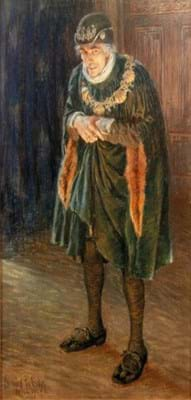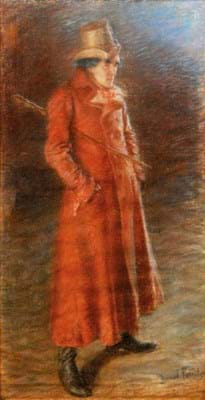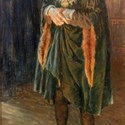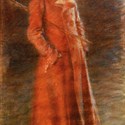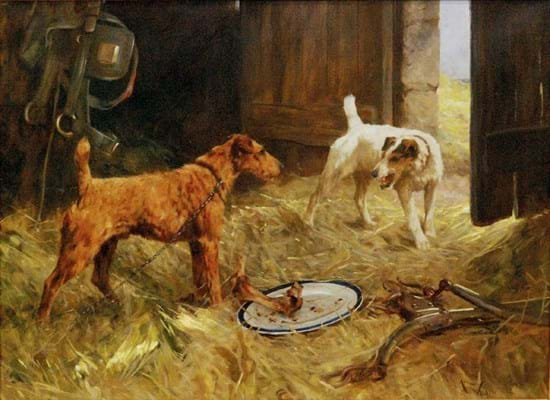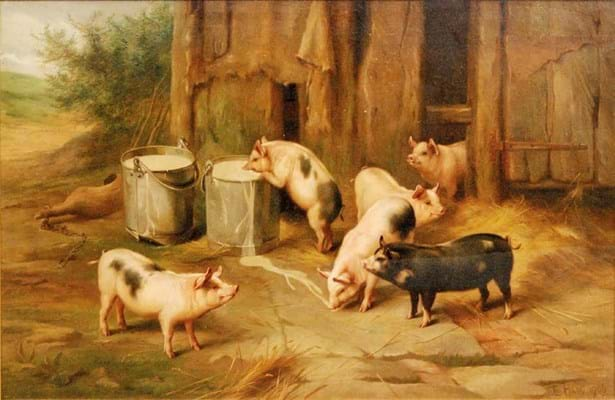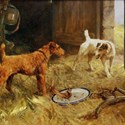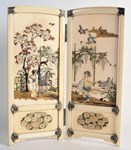Part of the late 19th century ‘gig economy’ perhaps, he acted at London’s Lyceum theatre using the stage-name ‘Bernard Gould’ while at the same time working as a church decorator and stained-glass craftsman.
He actually had some success treading the boards, continuing as a professional and “very clever player”, according to The Times, well after he joined Punch in 1891. He appeared in the first production of George Bernard Shaw’s Arms and the Man in 1894.
Although Partridge carried on acting until 1899, when he rose to ‘second cartoonist’ on Punch, arguably his main contribution to stage history was the drawings he made of playwrights and actors, especially the great Shakespearean actor Henry Irving (1838-1905).
He probably met Irving at the Lyceum, where Irving was both lead actor and company manager, and appears to have been employed to record the sets and costumes used in the most famous performances. Some of his sketches were later repurposed for use in albums and souvenir programmes.
While the V&A has a large collection of his drawings of Irving, few (if any) have emerged on the market in the last 25 years. On the relatively rare occasions when Partridge’s original works do appear at auction, they tend to be sketches and caricatures for Punch that fetch prices from £100-1000.
Stage right
However, two of Partridge’s drawings of Irving on stage were sold at Fieldings’ (20% buyer’s premium) sale in Stourbridge on September 2. They came as part of a consignment of five pictures and a few other items from a London source with theatrical connections.
Conveying the dramatic tension of two of the actor’s performances from 1877, these examples were probably based on earlier sketches which had been worked up into relatively large pastel drawings in 1906. Both measured 2ft 11in x 18in (90 x 46cm), were signed by Partridge, and had the relevant play, character and date of the performance inscribed on the verso.
With little market precedent, the West Midlands saleroom’s picture consultant William Lacey described them as “an unknown quantity” commercially and was free to pitch them at what, in hindsight, were relatively modest levels.
First up was a pastel drawing depicting Irving in his lead role as Richard III in January 1877, a play revived by Irving in the year before he became manager of the Lyceum. In good condition to boot, it attracted keen interest on the day, quickly exceeding its £600-800 estimate before coming down to a battle between two determined private bidders on the phone. It was eventually knocked down at £2800.
In character
Two lots later came a picture of Irving in the character of Dubosc in the melodrama The Lyon’s Mail, a play by Charles Reade set in revolutionary France. With a plot about mistaken identities, Irving played both the wicked highwayman Dubosc as well as his guileless lookalike Joseph Lesurques.
With the same £600-800 estimate, it again came down to the two private bidders and sold to the same buyer, this time at £2900.
These prices appear to be the highest sums fetched by Partridge portraits at auction, and they made a useful contribution to the overall £62,000 generated from the 92 lots in Fieldings’ picture section.
Animal attractions
The same was true of a collection of five farmyard scenes by Edgar Hunt (1876-1953) which came from a deceased estate. Offered separately, they all sold to a single collector for a combined £30,000.
Two of them sold on low estimate, including Piglet’s Feeding Time, a 20½in x 2ft 6in (52 x 76cm) signed oil on canvas dated 1906, which made the highest price of the group at £8000. Although the auctioneers were pleased to see them all get away, the muted competition demonstrated the drop-off in the artist’s market over the last 20 years, where prices for such works have generally come down.
Bone of contention
Generating a better contest on the day was Arthur Wardle’s (1860- 1949)The Bone of Contention. This 20in x 2ft 3in (51 x 68cm) signed oil on canvas of two dogs growling came from the same source as the Hunts.
Although works by Wardle come up regularly – and some parties who may have otherwise been interested were rather put off by the aggressive demeanour of one of the animals – the £1500-2000 estimate was not deemed excessive by a number of bidders, including the American buyer on the phone who secured it at £4300.


